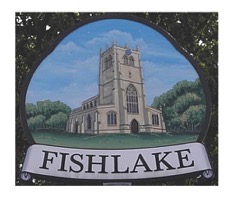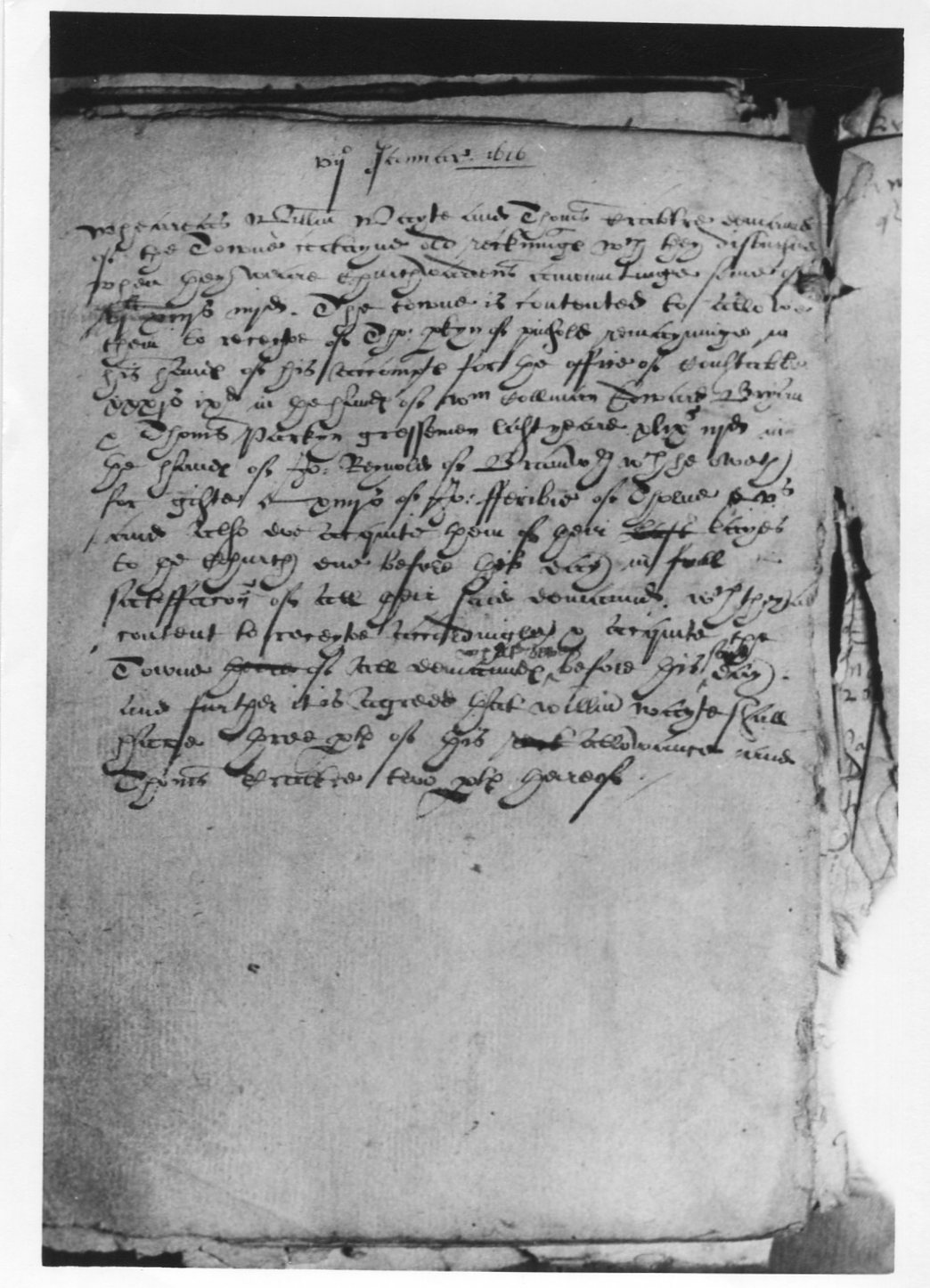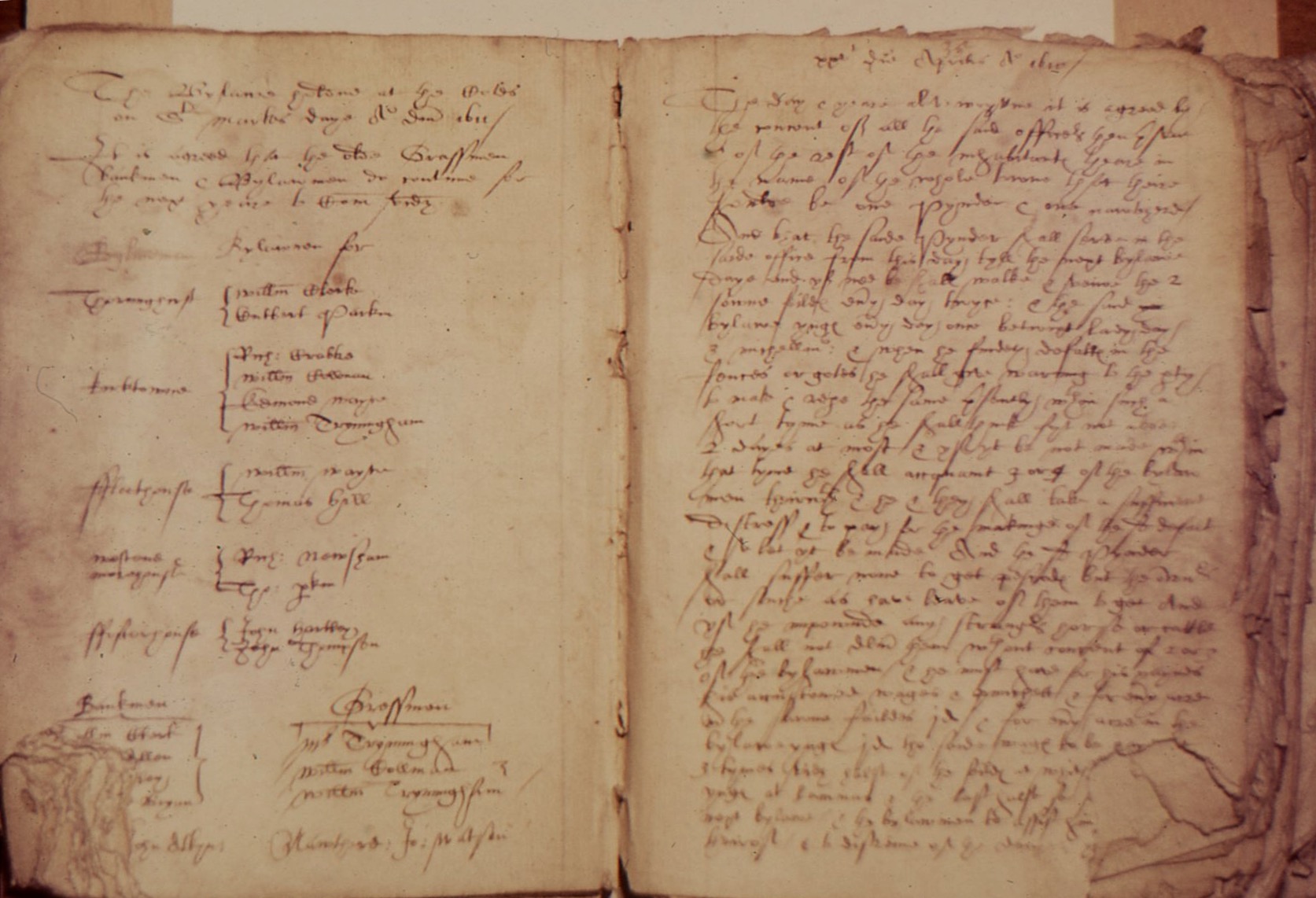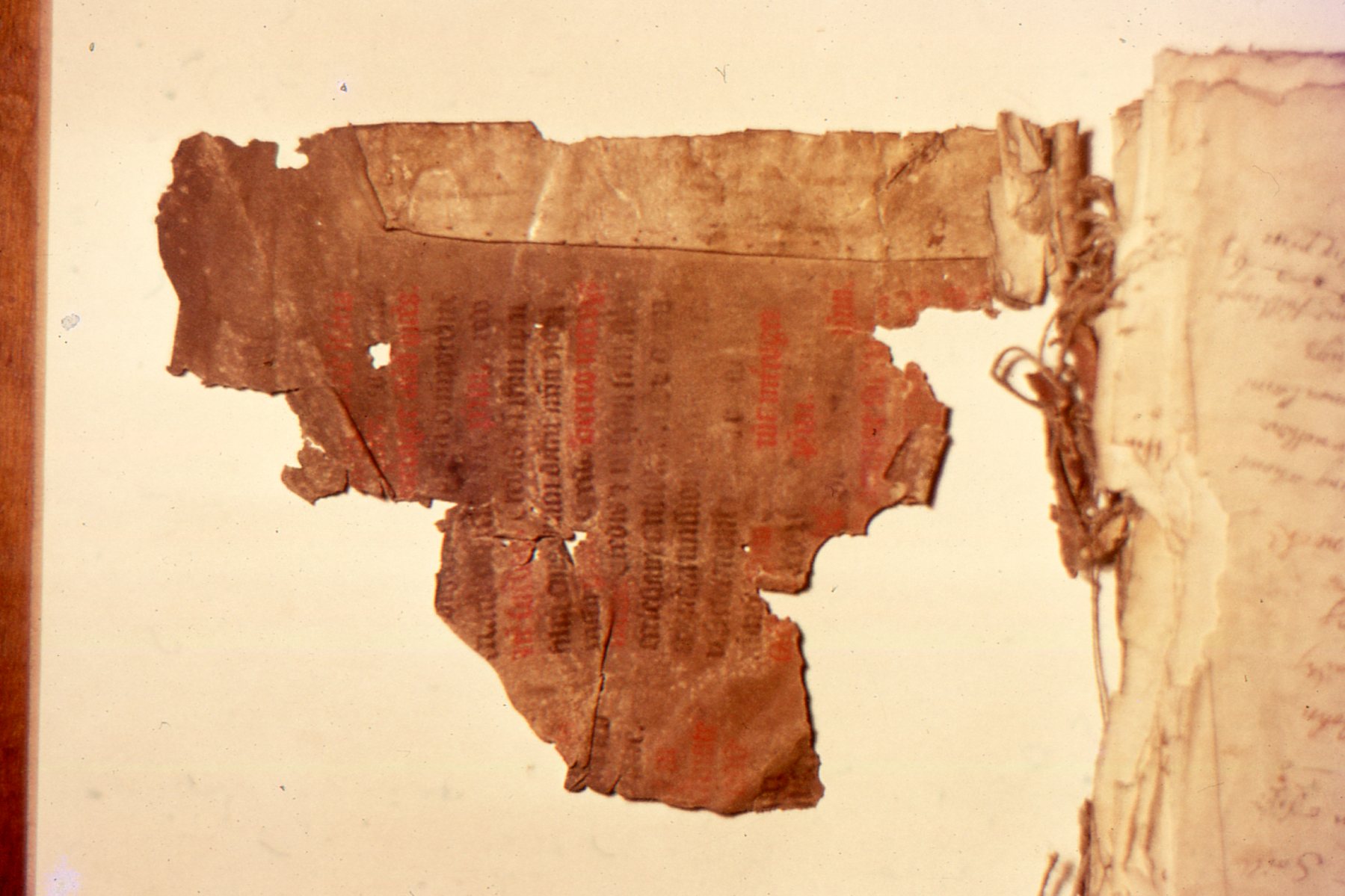The Bylaw Books and Bylawmen of Fishlake, Volume One 1582 -1674, Volume Two 1680 to 1808. An introduction with some background information.
The Fishlake Bylaw books are both important documents and records for local historians to study. These types of records are also a valuable source of research for economic and social historians. There are many reference to named individual providing a great source of additional information for the family historian. The original books are now in the care of Doncaster Archives and a transcription has been produced by the present author.
Volume one (1582-1674) of the Bylaw book itself measures 19.5 cm in length by 15 cm in width. It appears the original cover was replaced at some time during the 17 th century by a single parchment page torn out of a medieval missal. (a liturgical book containing all instructions and texts necessary for the celebration of mass throughout the year).
This volume is in poor state, the bottom right hand corner has been thumbed away and there is evidence of dampness in the past. Spinal stitching is also very loose and inadequate.
Front cover and page of volume one showing what is left of a parchment page from a Missal.
This volume one is by far the most interesting, not just due to its age but it also covers an interesting period of British history. The accounts list the names of the various officer elected yearly and give details of yearly expenditure for a wide variety of items, more details later. Further information is given in the form of memorandums detailing the practice, customs of the bylaw officers and their duties.
Volume one can be considered to begin in the year 1580 as the first page has been torn out and contemporary number sequence can be seen at the top of the page confirming this. In practice the accounts begin in 1582 and runs almost complete until 1674 except for a significant gap between 1625-1630 inclusive. This total absence of records at this period, and no evidence of pages being torn out, suggesting a period of suspension of township affairs most likely as a result of drainage operation in the adjacent parishes resulting in catastrophic flooding north of the river Don in both Fishlake and Sykehouse. I assume the ensuing chaos proved very disruptive to township affairs.
Volume two 1680 -1808. This book is bound in a hard cover, with a parchment overlay. It has been repaired with a new leather spine and re-stitching. Although broken off it has had two leather strap and corresponding hoops for fastening. The title page, at the back of the book, reads as follows;
“The By law Book of Fishlake.
Containing the yearly arts and orders of twelve men Elected and chosen yearly and every year on the 25 day of Old April out of the said town of Fishlake for to Redress Common Anoymiles in the common fields Ings and byways according to an ancient custom beyond the memory of man and continued year by year until this year 1679.”
On the opposite page is written; “This is a True Copy of the first leat which is now lost”. Leat meaning list or record.
Volume two follows a fairly similar pattern of recording lists of elected officers, restating official memorandum, detailing accounts of expenditure as well as money collected through for example trespassing on township commons, specially, for some reason, after 1735. It maybe that we are seeing the beginning of an increased intolerance of local inhabits to what would be seen as abuses of pasturing rights by non-residents.
The accounts vary in quality and quantity for year to year dependent on the skills of the scribe and their dedication to the work.
The coverage of both books includes the township of Fishlake and lands in Ditchmarsh (North of Thorne) of which Fishlake has ancient held rights. It does not cover the township of Sykehouse. We know from the Fishlake Bylaw Book that Sykehouse did have their own township officer including Grassmen etc.
The historical context to the bylaw administration.
The manor of Fishlake was under the manorial administration of the Great Court of Hatfield. Usually all township officers were elected and directly responsible to the Manor Court. However, by the end of the Middle Ages, manor courts tended to leave matters of open field organisations to the inhabitants, owners and their representatives, therefore the township organisation fell to the bylawmen and they created and enacted the bylaws. Therefore, the bylawmen were to a certain degree dissociated from the manor court, and the supervision and routine of the open fields became township business in which the lord of the manor played little part.
In effect this was a kind of agrarian cooperative in which all the inhabitants and their elected representative (bylawmen and parish officers) organised the day to day, year by year running of the township as an entry taken from the bylaw book for the year 1679 stated " to redress common anomalies in the common fields, Ings and byways according to ancient custom beyond the memory of man".
Between 1582 and 1808 the bylawmen made and enforced the bylaws and kept their accounts and records reflecting local agricultural practices and customs. Changing priorities over two centuries can be plotted especially regarding the open field system which became increasingly unpopular among the larger farmers. These accounts slowly diminished by 1800 when the open fields were finally enclosed by Act of Parliament 1812--1825. The accounts come to an end in 1808 as the role of the bylaw officers became redundant.This subject has already been covered in part by the late Dan Byford in his article Open Field Farming in Fishlake and Hatfield: The Evidence of the Court Books, 1582-1808. published in Aspects of Doncaster. Discovering Local History Ed by Brian Elliott 1997. Recommended reading. As Byford succinctly puts it the content of the books reflects the business and organising local agricultural practices in respect of the parish common lands.
The bylaw officers met to do business at the yearly Bylaw Court which was customarily held at the Court Gate in the Mill field (this location in modern Fishlake is not certain), a gate in old Norse meant an opening. This would imply an open air gathering of officers to establish rules, confirm practices and elect officers.
However, on special occasions meetings were held at alterative locations for example in May 23 rd 1667, “The bylaw being sumined to mete to Gether at hayven cros the day above written to serve the somses in the bylaw feild and Inges”. The haven cross I would say refers to what is now the Butter Cross in the village centre.
The customary day chosen for these meetings was 25 th April, St Marks Day. This day had strong significance, throughout the records there was no deviation from that date. Even after the official change to national calendar, local traditions remained unchanged. In1752 the Julian calendar (Old style) calendar was replaced by the Gregorian (NewStyle) calendar. This meant 12 days were lost and the first day of the year moved back from 1st March to 1st January. After 1754 all Bylaw meetings continued to be held on ‘Old St. Marks day’ now 6 May. This must surely indicate the importance given to that date. The Court start time was early, as recorded in a memorandum of 1680, “It’s agreed that the Old Bylawmen shall make their appeared at the Court held at Coat Gate the 25 th April at 7’0 clock morning, upon penalty of 6 pence or to stand on next year as the Court shall see fit.”
The fact that fines were necessary to encourage attendance at meetings shows a general lack of enthusiasm to engage in these duties.
The significance of using this particular patron saint, St Marks, for agrarian business, is not entirely clear but could well derive from the ancient rogation practice. There were 4 rogation days every year when the parish boundaries were perambulation in an organised procession led by a clergyman who said prayers blessing the crops for a fruitful harvest. The first three day were known as minor rogation day while the final and fourth day known as major rogation day which was held on 25 th April, St Marks day. The religious significance given to this Saint’s day may well explain the traditional appointment of 12 bylaw officers every year. 12 mirroring the 12 apostles.
Fishlake is a township of small settlements which is reflected in the organisation of the bylaw court. Every year representatives were chosen from all 5 principle settlements. The main settlement around the church called Kirktown had 4 representatives, others Thorninghurst, Fosterhouses, Fleethouse, Westend and Morehouse (sometimes Moorhouse Gate or even Morris Gate) all had two officers. Also, Sandgate which was only listed 1688 and 1690. Ratton Row first appears in 1691 possibly renaming Sandgate which does not appear again (location unknown but possibly refers to Hay Green as that is the only location with no representative.
Accounts for 7 th January 1616.
An example of a fairly typical yearly list of bylaw officers taken from 1596. (I have modernised the spellings).
Elected at the Bylaw Court in the year 1596.
Thorninghist Edmond Wait younger. Thomas Padley.
Fleet house Edmond Parkin. William Wait.
Kirktown Edmond Wait elder. William Goodridge. Richard Chester. John Parkin.
Morehouse and Westend. William Spark. Edward Hudson.
Foster house. Robert Heaton. William Goodridge.
Grassmen. Richard Newsome. William Allan. Thomas Parkin Newhouse.
Bankmen. Thomas Wayte. Dennis Hawson. Thomas Parkin, Pinfold. Thomas Parkin, Newhouse
The bylaws accounts include the duties and activities of the other bylaw officers in particular: Pinder, Nowtherd, Grassman, Bankman, Boatman later Ferryman.
Grassmen. Three officers chosen yearly. The duties of the grassmen were to oversee the grazing of the commons, especially the control of illegal grazing and the collection of fees from outsiders who sent animals to be pastured.
Boatman later Ferryman. One person appointed yearly. (See sperate article for details).
Banksmen. These were also under the control of the bylawmen at the bylaw court. Four banksmen were elected yearly to oversee the maintain the earthen riverside embankments primary on the South and eastern side the township. This office is primarily a product of a Fenland edge community confronted by drainage problems and flood risks.
There is a late 17 th century petition stating that the Fishlake river banks before 1630 were only 3 feet high and their cost of maintenance yearly was £8. The ultimate responsibility for embankment repairs and cost lay with the inhabitants the task of supervision and control rested with the bank men.
Yearly elections of bankmen continued up and until 1633 when the office appear to have been abolished. This can be explained as a results of the Vermuyden drainage operations during the late 1620's in the adjacent townships of Hatfield and Thorne the resulting catastrophic flooding on the Fishlake and Sykehouse side as a consequence generated complaints as a result the King in council ordered that the old banks at these places be put under the management of the participants (those involved in the drainage operation). In effect they took over the maintenance of the banks for the inhabitants and at the inhabitant expense. Consequently, the office of bankmen became obsolete.
Neatherd or Nowtherd meaning cattle herdsman. They assisted the Pinder in roundup stray animals and moving animals about from one place to another. A memorandum of April 25 1611 details their responsibilities.
A typical page from the Bylaw Book volume one page for 1610. On the left a list of elected bylawmen for that year and on the right a memorandum detailing the customs and practices of the Pinder and Nowtherd.
Pinder.
A manorial or parish office in charge of the pound or pinfold.
The Pinder at Fishlake was elected at the bylaw court every year and responsible to the bylawmen, the Pinder being an important officer in an open field village. His job was to impound livestock found straying about the township and to place them in a pound or pinfold, many still survive including a brick one in Fishlake.
(See separate article for a more comprehensive review).
The following are some examples, mostly taken from volume one, illustrating ranges of work and responsibilities undertaken by the elected bylaw officers taken from the bylaw records: (I have modernised the spellings).
Some payments were made to undertake the task of keeping accounts. 1608 William Alleyn hath received 7s 4d of the town for making the grave book (see glossary) which book is belonging to the town.
Electing and overseeing the work of the other subsidiary officers.
Plenty of examples elsewhere.
Parish security and armoury.
Item 1582 Thomas Atkin for half a pound of gunpowder 8d.
1583 paid to Mr Parkyn for a plank for stocks and gunpowder 6s 4d.
1584 paid to Edmund [ ? ] for carrying a prisoner to York 2s
Collection of rents including Dichmarsh, North of Thorne.
Richard Parkin 1582 where of he paid 10s for dichmarsh rent.
Collecting pasturing fees, a significant part of the officer’s work.
In 1610 William Allyn received of Lawrence Hutchinson for 3 horses 15s.
Item of Thomas Drinkrow for 43 swine 26s.
Some came from a distance. Item of Cocker of Rotherham for a grey nag 2s 6d.
Agistment (see glossary) money.
1603 Thomas Bryan hath received for gist money this year already £4 10s 4d.
Drainage repairs and maintenance, to reduce the risk of flooding.
Item for work men’s wage for mending the Clowe at Haygreen Cross. 10d.
1688 Jo Bettony two days goyting on the Nab 1s 6d.
Payments to other township officers.
1591 Item to the Constable 7s 6d.
1603 That upon general reckoning made by the churchwardens and the town, that the town of Fishlake is owing to Thomas Parkin and Edmond Waite churchwardens all things accounted the sum of 16s.
Travel expenses.
1592 Item which spent going to Conisbrough 8d.
Payments to the poor.
1594 given the 28 April to a poor man 6d.
Again, on 3 May to a poor man 6d.
Bridge repairs.
In 1588 John Trimingham for board for Bind bridge (located on near the Far Bank over Taining Drain). 12s
1687 for a horse bridge making over the taining. £1. 1s. 8d.
Road repairs usually known as Causeways.
1713 paid Richard Johnson for taking up the causey against the parsning and making a new one 58 yards long at 2d a yard. 12s.
Access road repairs.
1674 Item for repairing pator balk (Balk an uncultured strip of land, often grass, giving access to cultivated strips necessary in an open field system) in the millfield 2s. 6d.
Refreshments. The practice of expenditure of food and drink became common after 1680 maybe to encourage more participation in township business.
1710 Ale and meat for the bylaw meeting.
Provision for flood risk incorporated into agreement.
The common piece letten to Thomas Actkin again his close for this year 1665 10s. and if it be flooded before he mow, he is to have at or about midsummer that his hay be spoiled paid then the town is to give or allow 5s back.
New House building in 1615.
Evidence for another form of income came from the commons raised by the bylaw court involving the granting of common rights to the building of new houses. In 1615 Thomas Wayte of Fosterhouses given right to build one new house 20s. Robert Bladworth 6s 8d for a similar right to build a new house.
Communication work.
1598 3d for sending word to the grassman of Sykehouse.
Bylaw men undertaking field inspections.
The bylaw men being met to gather the 23 May 1667. To view all those common water courses and finding the double dike is warped up very high…..
The supplying of boats for the river crossing. Fishlake being separated as it is by the river Don from other parts of its common lands necessitated the provision for a ferry crossing.
1582 for town boat 8d.
1587 William Trimingham 2 pieces of wood to make town boat nails 8d.
1590 George Gibson for finding ropes for the town boat.
1598 William Allen for finding of ropes for whole year for our town boat and for keeping her in them at the waterside.
A glossary of agrarian terms used in the Bylaw Book and elsewhere.
Agisting, Gist. A term used to mean pasturing animals for a fee on Fishlake commons by other townships.
Ancient. A legal term meaning beyond the memory of man i.e. no one old enough can remember.
Ancient Stiles or Gates. They are marked on the Enclosure Map and listed in the Grave Book, 33 Stiles are recorded in all. They appear to be physical structures (stile) which are markers or boundaries of land tenancy or ownership for manorial rent purposes.
Balk. Balk an uncultured strip of land, often grass, giving access to cultivated strips necessary in an open field system.
Causey or Causeway. A raised pathway, paved with stone or cobbles, a paved road, especially over marsh or water.
Clowe. Sluice gate to manage water. Door hung at the end of a drain.
Drift. Corralling on the common to check for illegal grazing, offenders were fined.
Gate. 1) Road, cattle walk or pasture. 2) The right or privileged of pasturage for cattle etc either free on common ground, or by arrangement on private ground.
Glean or gleaning. To gather (for example grain) after a harvest.
Grave. A steward, a person in charge of the grave.
Graveship. Subdivision of a manorial territory for the purposes of collecting rents.
Grip or Goyted. To cut grips or small drains for draining (open surface drains). Goyted or goit meaning a water channel.
Howl or Howle. Tunnel or culvert under a road or bank.
Nab or Nabb. Hillock, projecting peak.
Sidlings. A strip of land often alongside a river.
Stile. See Ancient Stiles or gates.
Taining (drain) a device for catching fish. This strongly suggests that the Taining Drain was in fact constructed and used not just for drainage purposes but primarily as a fish catching structure. It originally ran as a loop connecting to the river near Fishlake village and to the river on the opposite side of the bank to Stainforth. Therefore, we have a dual-purpose land drain.
The parchment back cover, or whats left, showing latin script.
The bylaw books provide a fascinating insight into agricultural life in Fishlake many years ago. The above is intended to convey a flavour of their content which well derives further study.
Rob Downing 25 April 2020.




